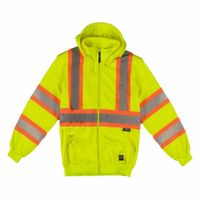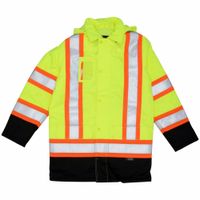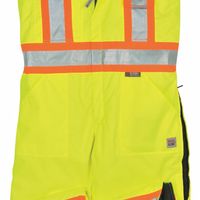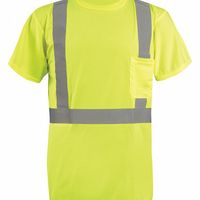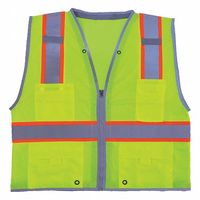Call +(254) 703 030 000 / 751 483 999 / 721 704 777
- Home
- Safety
- Protective Clothing
- High Visibility Protective Clothing
.....Read More
Frequently Asked Questions
What is high-visibility clothing?
High-visibility clothing, often referred to as hi-vis or reflective clothing, is specialized apparel designed to make the wearer more visible in various environments, particularly in low-light or high-risk situations. This type of clothing is commonly used in industries such as construction, road work, emergency services, and by cyclists or pedestrians who need to be seen by drivers.
The primary feature of high-visibility clothing is its bright, fluorescent colors, such as neon yellow, orange, or green, which stand out against most backgrounds during daylight. These colors are chosen for their ability to reflect more light and be easily detected by the human eye. In addition to the fluorescent material, high-visibility clothing often includes reflective strips or tape. These reflective elements are crucial for visibility in low-light conditions, such as at night or in fog, as they reflect light from sources like vehicle headlights back towards the source, making the wearer more noticeable.
High-visibility clothing is typically made from durable, weather-resistant materials to withstand various working conditions. It is available in different forms, including vests, jackets, pants, and coveralls, allowing for full-body visibility. The clothing is often designed to meet specific safety standards and regulations, which vary by country and industry, ensuring that it provides adequate protection and visibility.
Overall, high-visibility clothing is an essential safety measure that helps prevent accidents and injuries by ensuring that individuals are easily seen, thereby reducing the risk of collisions and enhancing overall safety in potentially hazardous environments.
Why is high-visibility clothing important?
High-visibility clothing is crucial for ensuring safety in environments where individuals are at risk of not being seen by others, particularly in low-light or high-traffic situations. This type of clothing is designed with fluorescent colors and reflective materials that enhance visibility during both daytime and nighttime.
During the day, fluorescent colors such as neon yellow, orange, and green stand out against most backgrounds, making it easier for others to spot the wearer. At night or in low-light conditions, reflective strips on the clothing catch and reflect light from sources like vehicle headlights, making the wearer visible from a distance.
High-visibility clothing is essential for workers in construction, road maintenance, and emergency services, where being seen can prevent accidents and save lives. It is also important for cyclists, pedestrians, and motorcyclists who share the road with vehicles. By increasing visibility, this clothing reduces the risk of accidents caused by drivers not noticing people in their vicinity.
Moreover, high-visibility clothing is often a regulatory requirement in many industries, ensuring that safety standards are met to protect workers. It is a simple yet effective measure that significantly enhances personal safety by making individuals more noticeable in potentially hazardous environments.
What are the standards for high-visibility clothing?
High-visibility clothing standards are designed to ensure the safety of individuals working in environments where visibility is crucial. The primary standards include:
1. **ANSI/ISEA 107 (United States):** This standard specifies the design, performance, and materials for high-visibility safety apparel. It categorizes garments into three classes based on the level of visibility and risk:
- **Class 1:** For low-risk environments, such as parking lot attendants.
- **Class 2:** For higher-risk environments, like road construction workers.
- **Class 3:** For the highest risk, such as highway workers, requiring the most visibility.
2. **EN ISO 20471 (International/Europe):** This standard outlines requirements for high-visibility clothing to ensure visibility in daylight, low light, and nighttime conditions. It specifies the minimum areas of fluorescent and retroreflective materials and categorizes garments into three classes:
- **Class 1:** Lowest level of visibility.
- **Class 2:** Intermediate level.
- **Class 3:** Highest level, requiring the most material.
3. **AS/NZS 4602.1 (Australia/New Zealand):** This standard specifies the design and performance of high-visibility safety garments for daytime and nighttime use. It includes requirements for fluorescent and retroreflective materials.
Key elements across these standards include:
- **Fluorescent Material:** Enhances visibility in daylight.
- **Retroreflective Material:** Reflects light back to its source, crucial for nighttime visibility.
- **Design Requirements:** Placement and amount of materials to ensure 360-degree visibility.
- **Color Specifications:** Typically fluorescent yellow, orange, or red.
These standards ensure that high-visibility clothing provides adequate protection by enhancing the wearer's visibility to others, thereby reducing the risk of accidents in hazardous environments.
How do I choose the right high-visibility clothing?
To choose the right high-visibility clothing, consider the following factors:
1. **Standards and Regulations**: Ensure the clothing meets local safety standards, such as ANSI/ISEA 107 in the U.S. or EN ISO 20471 in Europe. These standards classify garments based on visibility and reflectivity.
2. **Class and Type**: Select the appropriate class and type based on your work environment. Class 1 is for low-risk areas, Class 2 for medium-risk, and Class 3 for high-risk environments. Type O is for off-road, Type R for roadways, and Type P for public safety.
3. **Color**: Choose bright colors like fluorescent yellow-green, orange-red, or red, which are easily visible in various lighting conditions.
4. **Reflective Material**: Ensure the clothing has sufficient reflective tape or material to enhance visibility in low-light conditions. The placement and width of the reflective strips are crucial for maximum visibility.
5. **Fit and Comfort**: The clothing should fit well, allowing for ease of movement without being too loose or tight. Consider the work environment and weather conditions to choose appropriate materials for comfort.
6. **Durability and Maintenance**: Opt for durable materials that can withstand the work environment. Check care instructions to ensure the clothing maintains its visibility after washing.
7. **Additional Features**: Consider features like pockets, zippers, or hoods based on your specific needs. Breathable fabrics or moisture-wicking properties can enhance comfort.
8. **Layering**: If layering is necessary, ensure all layers are high-visibility to maintain safety.
By considering these factors, you can select high-visibility clothing that ensures safety, comfort, and compliance with relevant standards.
How should high-visibility clothing be maintained?
High-visibility clothing should be maintained with care to ensure its effectiveness and longevity. Follow these guidelines:
1. **Regular Inspection**: Frequently check for signs of wear and tear, such as fading, rips, or missing reflective strips. Replace any damaged clothing immediately to maintain safety standards.
2. **Proper Washing**: Wash high-visibility clothing separately from regular laundry to prevent contamination. Use mild detergent and avoid bleach or fabric softeners, which can degrade reflective materials. Follow the manufacturer's washing instructions, typically recommending cold or warm water.
3. **Gentle Drying**: Air-dry the clothing whenever possible. If using a dryer, select a low-heat setting to prevent damage to the reflective materials. Avoid ironing reflective areas.
4. **Storage**: Store in a cool, dry place away from direct sunlight to prevent fading. Hang the clothing to maintain its shape and avoid folding, which can cause creases that may damage reflective strips.
5. **Avoid Contaminants**: Keep away from oils, solvents, and other chemicals that can degrade the fabric and reflective materials. If contamination occurs, clean the clothing promptly.
6. **Follow Manufacturer's Guidelines**: Adhere to any specific maintenance instructions provided by the manufacturer to ensure compliance with safety standards.
7. **Replacement**: Regularly assess the clothing's visibility performance. Replace it if the fluorescent color or reflective strips lose their effectiveness, typically every 6 months to 1 year, depending on usage and exposure conditions.
By following these maintenance practices, high-visibility clothing will remain effective in enhancing safety by ensuring the wearer is easily seen in various conditions.
What materials are used in high-visibility clothing?
High-visibility clothing is designed to make the wearer easily discernible from any background, especially in low-light conditions. The materials used in these garments are selected for their reflective and fluorescent properties.
1. **Fluorescent Materials**: These are typically made from bright, vivid colors like neon yellow, orange, and lime green. The fabric is often polyester or a polyester blend, which is durable and holds color well. Fluorescent dyes absorb ultraviolet light and re-emit it as visible light, enhancing visibility during daylight.
2. **Reflective Materials**: Reflective strips or tapes are crucial for visibility in low-light or nighttime conditions. These are usually made from micro-prismatic or glass bead technology. Micro-prismatic materials consist of tiny prisms that reflect light back to its source, while glass bead technology uses microscopic glass spheres embedded in a polymer layer to achieve the same effect. These materials are often applied to the garment in strips or patterns.
3. **Base Fabric**: The base fabric of high-visibility clothing is typically a durable, weather-resistant material like polyester or a polyester-cotton blend. These fabrics are chosen for their strength, resistance to environmental conditions, and ability to hold fluorescent dyes.
4. **Coatings and Finishes**: Some high-visibility clothing may have additional coatings for water resistance or flame retardancy, depending on the intended use. These coatings are applied to enhance the garment's functionality without compromising visibility.
5. **Additional Features**: Some garments may include mesh panels for breathability, adjustable closures for fit, and pockets for functionality, all made from compatible materials that do not interfere with the garment's visibility.
These materials work together to ensure that high-visibility clothing meets safety standards and provides maximum visibility in various working conditions.
Who is required to wear high-visibility clothing?
High-visibility clothing is required for individuals working in environments where there is a significant risk of accidents due to low visibility or where they need to be easily seen by others. This includes:
1. **Construction Workers**: Those working on or near roadways, construction sites, or heavy machinery need to be visible to operators and drivers to prevent accidents.
2. **Roadside Workers**: This includes highway maintenance crews, utility workers, and emergency responders who work near traffic and need to be seen by drivers.
3. **Warehouse and Factory Workers**: In environments with moving vehicles like forklifts, high-visibility clothing helps prevent collisions.
4. **Airport Ground Crew**: Personnel working on runways and near aircraft need to be visible to pilots and other ground staff.
5. **Railway Workers**: Those working on or near train tracks need to be visible to train operators to ensure safety.
6. **Cyclists and Pedestrians**: In some regions, cyclists and pedestrians are encouraged or required to wear high-visibility clothing, especially in low-light conditions, to be seen by motorists.
7. **Event Staff and Security Personnel**: At large events, staff and security personnel wear high-visibility clothing to be easily identifiable by attendees and emergency services.
8. **Emergency Services**: Police, firefighters, and paramedics often wear high-visibility gear to be seen quickly in emergencies.
9. **Hunters**: In some areas, hunters are required to wear high-visibility clothing to prevent accidental shootings.
Regulations and requirements for high-visibility clothing can vary by country and industry, often guided by safety standards and occupational health and safety laws.

